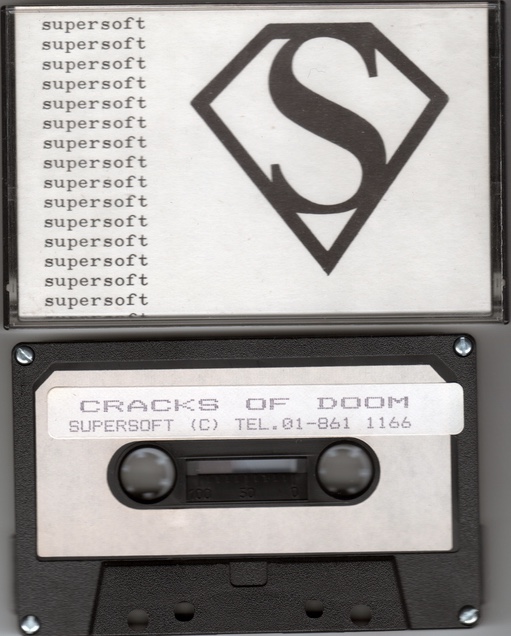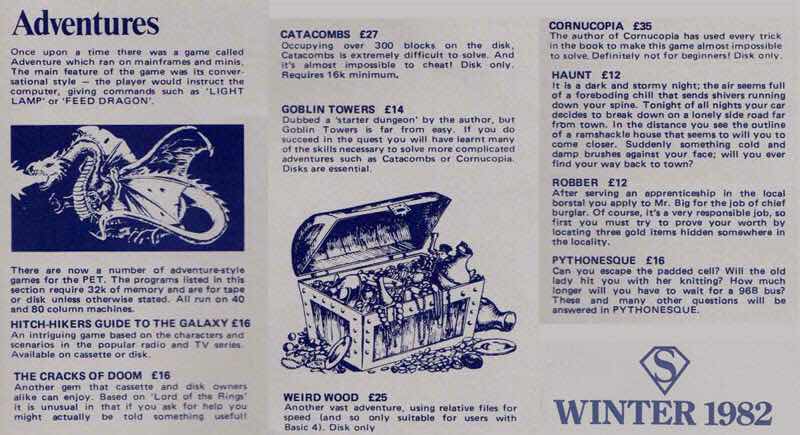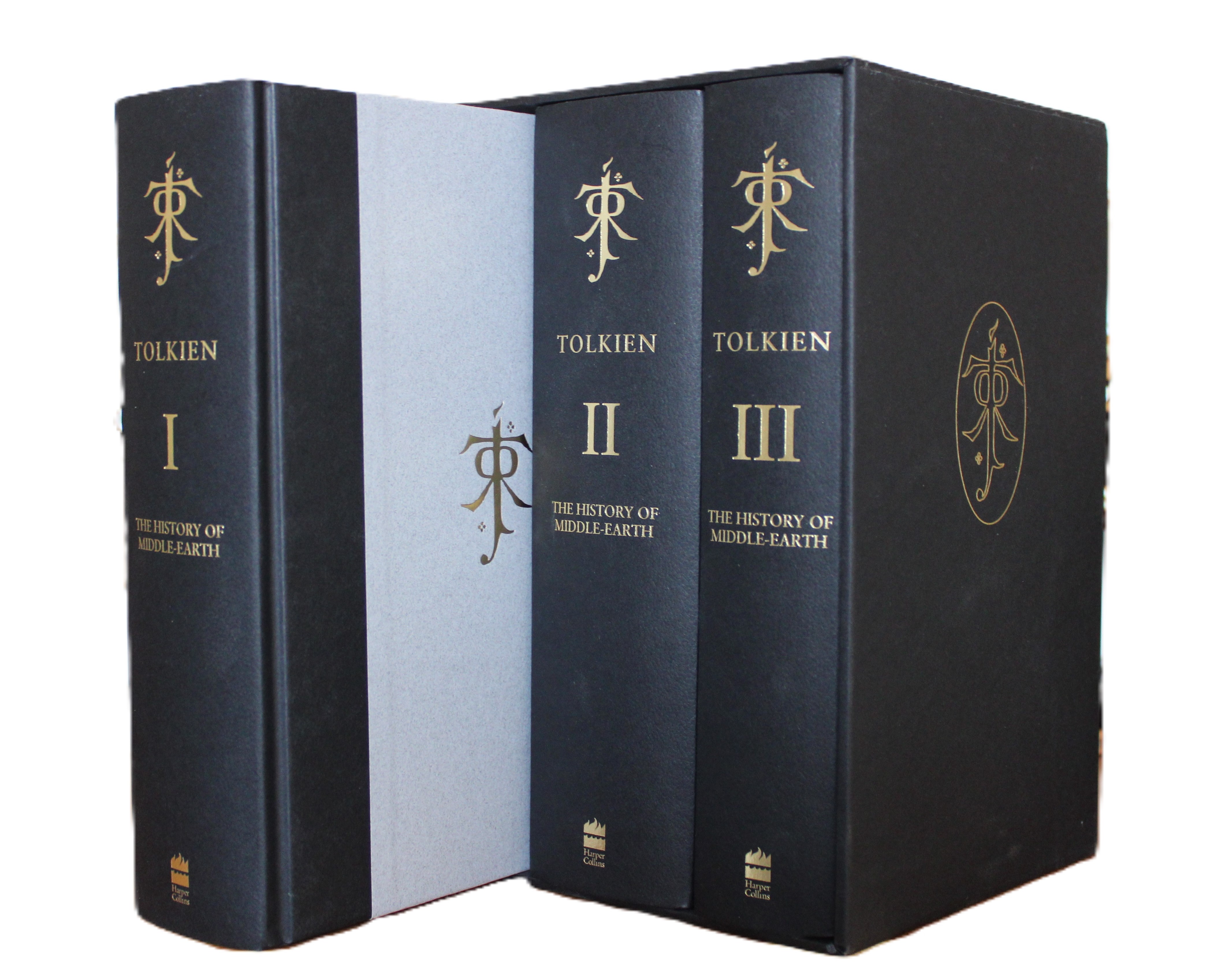Early Unlicensed Computer Games
13 May, 2023
(edited)
2023-5-13 9:55:31 AM UTC
2023-5-13 9:55:31 AM UTC
Trying to come up with a list of Collectable Computer Games is very hard. This is because there were a lot of games written but a lot of them were not commercially available, they were either public domain or shareware, meaning that they were available to copy, download and share freely. This means that there is nothing physical to collect unless you include homemade copies of disks and tapes, which I don’t really count. Therefore I will not be including any of these in this article, particularly some of the first adventure games, written on large early mainframe computers.
The second thing to consider is how much a game is based on Tolkien. Some games are fully based on Tolkiens works, some are only named after Tolkiens works or characters but the game itself has very little to do with Tolkien, or the game only features aspects of Tolkien within it (characters or place names etc) but with the rest/most of the game having nothing to do with Tolkien.
In this article I am also not including any parody games which were produced at the time, I will do a separate article on those.
This article is focusing on the very early unlicensed games (so does not include the Melbourne House Hobbit and Lord of the Rings games, I have already done some specific articles on those) and is only looking at the early games from the 1980’s.
First up is Lord of the Rings produced by Kansas for the TRS-80 in 1981. It is arguably the first commercial Tolkien computer game. It is fully based on Tolkiens works, although I don’t know how involved the game is. The cassette cover for the game is very bland, being a generic blue Kansas cover.

There were adverts for the game in the Computer & Video Games magazine issues 3 and 4.

Cracks of Doom was produced by Supersoft for the Commodore 64 and PET in 1982. Not to be confused with the Addison-Weasley The Crack of Doom game. It appears to be a fully Tolkien based game.

There was a review for it in Computer & Video Games magazine issue 3.

And an advert in the 1982 Supersoft catalogue.

This game had some copyright problems and was re-released as Cracks of Fire with specific Tolkien names replaced.

Shadowfax was produced by Postern for the Commodore VIC 20, ZX Spectrum, Commodore 64 and BBC in 1982. Although this is fully themed on Tolkiens works, it is quite a simple, generic game.

It was also available in big box packaging.

And it was also available in Spain, published by Indescamp, with different packaging.

The game was featured in the Commodore VIC starter pack.

There was a review of the game in Personal Computer Games magazine, summer 1983 issue.

Level 9’s “Middle-earth Trilogy” from 1982 consisted of three adventure games (Adventure Quest, Colossal Adventure and Colossal Quest). These games were available for most of the Computer Systems of the time. This trilogy is supposed to be set in Middle-earth after the end of the Lord of the Rings, however the first game is a version of the first ever mainframe adventure game with an extra bit tagged on the end, with minimal Tolkien references. The other two games have some Tolkien references, particularly in the pre-amble, but the actual games themselves are not really Tolkien based. When the games were re-released, as the Jewels of Darkness trilogy, any Tolkien references were removed.

The games were featured in variations of the following advert in many magazines at the time.

Moria was produced by Severn Software for the ZX Spectrum and Oric in 1983, there may also have been a Commodore 64 version, but I have never seen a copy. This again is based on Tolkiens work, but again is quite a simple game. Please note that there are other, freeware, games with the same name.

There is not much detail available about this game, however variations on the following advertisement appeared in magazines at the time.

Lord of the Balrogs was produced by Supersoft for the Commodore 64 in 1983. This game is not really Tolkien based at all apart from the name, although it does feature an ‘Eye of Smaug’ artefact. I have not found any advertisements for this game.

Gandalf the Sorcerer was produced by Game Gems for the Commodore 64 in 1984. This game is also not really Tolkien based apart from the name (even the Spectrum version did not have a Tolkien name, it was called Sodov the Sorcerer).

The game was featured in the following advert in various magazines.

Magazines of the time had reviews of the game.

Las Tres Lucas De Glaurung (The Three Jewels of Glaurung) was produced by Erbe Software for the ZX Spectrum, Amstrad and MSX in 1986. It was only released in Spain. This game is also not really Tolkien based apart from the name. It was later re-released as Conquistador.

The following advert for the game featured in various magazines.

Spanish magazine MicoHobby (Issue 90, August 1986) featured the game on the cover and had a three page article, including map.

Other Games
There are a few games where there is evidence that they were commercially available, however there is very little detail about them and I have never seen any actual copies. They may have been advertised but never actually released.
Lord of the Rings: Part 1 was produced by CPS Games/Holdco for the ZX81, Atari 400 and Apple 2 in 1982. Not to be confused with the Melbourne House Lord of the Rings Game One game. It appears to be a fully Tolkien based game. It looks like this was the first in a planned series of games, however there is no evidence at all that any others were produced. There were various adverts for it in magazines at the time.

Ring of Doom (published as Odesringen in Sweden) was produced by Microworld for the Microbee in 1983. It also appears to be a fully Tolkien based game. There was an advert for it in the Australian Personal Computer magazine March 1984.

The second thing to consider is how much a game is based on Tolkien. Some games are fully based on Tolkiens works, some are only named after Tolkiens works or characters but the game itself has very little to do with Tolkien, or the game only features aspects of Tolkien within it (characters or place names etc) but with the rest/most of the game having nothing to do with Tolkien.
In this article I am also not including any parody games which were produced at the time, I will do a separate article on those.
This article is focusing on the very early unlicensed games (so does not include the Melbourne House Hobbit and Lord of the Rings games, I have already done some specific articles on those) and is only looking at the early games from the 1980’s.
First up is Lord of the Rings produced by Kansas for the TRS-80 in 1981. It is arguably the first commercial Tolkien computer game. It is fully based on Tolkiens works, although I don’t know how involved the game is. The cassette cover for the game is very bland, being a generic blue Kansas cover.

There were adverts for the game in the Computer & Video Games magazine issues 3 and 4.

Cracks of Doom was produced by Supersoft for the Commodore 64 and PET in 1982. Not to be confused with the Addison-Weasley The Crack of Doom game. It appears to be a fully Tolkien based game.

There was a review for it in Computer & Video Games magazine issue 3.

And an advert in the 1982 Supersoft catalogue.

This game had some copyright problems and was re-released as Cracks of Fire with specific Tolkien names replaced.

Shadowfax was produced by Postern for the Commodore VIC 20, ZX Spectrum, Commodore 64 and BBC in 1982. Although this is fully themed on Tolkiens works, it is quite a simple, generic game.

It was also available in big box packaging.

And it was also available in Spain, published by Indescamp, with different packaging.

The game was featured in the Commodore VIC starter pack.

There was a review of the game in Personal Computer Games magazine, summer 1983 issue.

Level 9’s “Middle-earth Trilogy” from 1982 consisted of three adventure games (Adventure Quest, Colossal Adventure and Colossal Quest). These games were available for most of the Computer Systems of the time. This trilogy is supposed to be set in Middle-earth after the end of the Lord of the Rings, however the first game is a version of the first ever mainframe adventure game with an extra bit tagged on the end, with minimal Tolkien references. The other two games have some Tolkien references, particularly in the pre-amble, but the actual games themselves are not really Tolkien based. When the games were re-released, as the Jewels of Darkness trilogy, any Tolkien references were removed.

The games were featured in variations of the following advert in many magazines at the time.

Moria was produced by Severn Software for the ZX Spectrum and Oric in 1983, there may also have been a Commodore 64 version, but I have never seen a copy. This again is based on Tolkiens work, but again is quite a simple game. Please note that there are other, freeware, games with the same name.

There is not much detail available about this game, however variations on the following advertisement appeared in magazines at the time.

Lord of the Balrogs was produced by Supersoft for the Commodore 64 in 1983. This game is not really Tolkien based at all apart from the name, although it does feature an ‘Eye of Smaug’ artefact. I have not found any advertisements for this game.

Gandalf the Sorcerer was produced by Game Gems for the Commodore 64 in 1984. This game is also not really Tolkien based apart from the name (even the Spectrum version did not have a Tolkien name, it was called Sodov the Sorcerer).

The game was featured in the following advert in various magazines.

Magazines of the time had reviews of the game.

Las Tres Lucas De Glaurung (The Three Jewels of Glaurung) was produced by Erbe Software for the ZX Spectrum, Amstrad and MSX in 1986. It was only released in Spain. This game is also not really Tolkien based apart from the name. It was later re-released as Conquistador.

The following advert for the game featured in various magazines.

Spanish magazine MicoHobby (Issue 90, August 1986) featured the game on the cover and had a three page article, including map.

Other Games
There are a few games where there is evidence that they were commercially available, however there is very little detail about them and I have never seen any actual copies. They may have been advertised but never actually released.
Lord of the Rings: Part 1 was produced by CPS Games/Holdco for the ZX81, Atari 400 and Apple 2 in 1982. Not to be confused with the Melbourne House Lord of the Rings Game One game. It appears to be a fully Tolkien based game. It looks like this was the first in a planned series of games, however there is no evidence at all that any others were produced. There were various adverts for it in magazines at the time.

Ring of Doom (published as Odesringen in Sweden) was produced by Microworld for the Microbee in 1983. It also appears to be a fully Tolkien based game. There was an advert for it in the Australian Personal Computer magazine March 1984.












 117
117 17029
17029